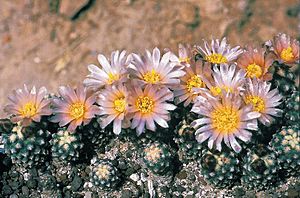Knowlton's miniature cactus facts for kids
Quick facts for kids Knowlton's miniature cactus |
|
|---|---|
 |
|
| Conservation status | |
| Scientific classification | |
| Kingdom: | |
| (unranked): | |
| (unranked): | |
| (unranked): | |
| Order: | |
| Family: | |
| Genus: | |
| Species: |
P. knowltonii
|
| Binomial name | |
| Pediocactus knowltonii L.D.Benson
|
|
Pediocactus knowltonii is a very rare type of cactus. People often call it Knowlton's miniature cactus or Knowlton's pincushion cactus. It is one of the smallest cacti in the world.
Contents
Where It Lives and Its Home
This tiny cactus grows only in one special place. It is found in San Juan County, New Mexico, in the United States. This means it is endemic to that area. There is only one known group of these cacti. This group lives on a piece of land about 12 acres big.
In 2008, there were about 6,100 of these cacti. The plants grow very close to the Colorado border. They have been seen just 30 meters from Colorado. But they do not actually grow inside Colorado.
This cactus likes to live in pinyon-juniper woodlands. It also grows in sagebrush areas. The soil it prefers is loamy and gravelly. Sometimes, the ground is covered with small rocks. The cactus can grow in open sunny spots. It can also grow in the shade of bigger plants.
Protecting This Cactus
This cactus is the smallest and rarest type in its group, Pediocactus. Many human activities threaten it. Because it is so rare, the United States government lists it as an endangered species. This means it is in danger of disappearing forever.
Part of the area where it grows is fenced off. This helps protect the plants. The Nature Conservancy, a conservation group, helps to keep them safe.
Why It's in Danger
Scientists found this plant in 1958. Soon after, many cactus collectors wanted it. They dug up many plants to add to their collections. Within 20 years, the number of cacti dropped a lot. When it was found, there might have been 100,000 plants. By 1978, only about 1,000 were left.
Even today, collectors still want this cactus. Its small size and rarity make it special. You can even find its seeds for sale online.
Other things also threaten the cactus. People using off-road vehicles can damage its home. New buildings and developments near the area are also a problem. Oil and gas drilling happens a lot in this region. Farm animals like livestock graze nearby, which can harm the plants.
Long periods without rain, called drought, can also reduce the number of cacti. Small animals like mice love to eat the cactus fruits. This means fewer seeds are left to grow new plants.
What It Looks Like
This is a very tiny cactus. It can grow up to 55 millimeters tall. It can be up to 30 mm wide. Often, it is even smaller. Some are about the size of a US penny. A cactus is considered an adult when it is wider than 10 mm.
The cactus is usually round or a bit like a cylinder. It has small, round spots called areoles. These areoles are covered in tiny hairs. Each areole has up to 26 thin spines. These spines are red, pink, or white. They are very short, less than 2 mm long.
The plant grows a beautiful flower. The flower can be up to 35 mm long and 25 mm wide. It has pinkish petals, called tepals. The outer petals have brownish stripes down the middle.
After the flower, a small fruit grows. The fruit is green at first. It turns reddish when it is ripe. It is about 4 mm long. Scientists think this cactus might have come from a bigger cactus. It may have started as a mutation of the Pediocactus simpsonii species.
See also
 In Spanish: Pediocactus knowltonii para niños
In Spanish: Pediocactus knowltonii para niños



